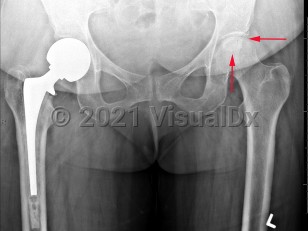Classic history and presentation: Patients describe achy, throbbing groin pain that may be referred to the knee or buttock. In more advanced disease stages, patients experience limited range of motion and difficulty bearing weight on the affected leg.
Prevalence:
- Osteonecrosis of the femoral head typically presents between the ages of 35 and 50 years and is more common in males than in females.
- Bilateral hips are affected in 80% of cases.
- Three percent of patients with atraumatic AVN have multifocal involvement (3 or more sites).
- Trauma, especially femoral neck fracture
- Glucocorticoids
- Marrow-replacing diseases (eg, Gaucher disease)
- Hematologic diseases (eg, sickle cell disease)
- Caisson disease
- Irradiation
- Systemic lupus erythematosus
- Alcohol use disorder
- Hypercoagulable states
- Organ transplant
- Viruses
- Protease inhibitors
Grade / classification system: The Ficat classification system is based on plain x-rays and the patient's symptoms.
- Stage 0: normal x-rays, asymptomatic; "silent hip" if patient has known contralateral AVN
- Stage I: normal x-rays or subtle trabecular blurring or osteopenia; pain and limited hip range of motion
- Stage II: normal contour of the femoral head but with cystic or sclerotic evidence of bone remodeling; worsening clinical signs
- Stage III: "crescent sign," abnormal contour or flattening of the femoral head from subchondral collapse with joint space preserved
- Stage IV: degenerative osteoarthritis with narrowed joint space and osteophytes; progressively diminished hip motion


